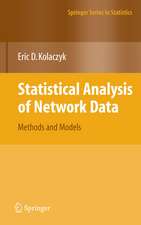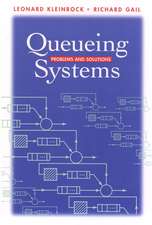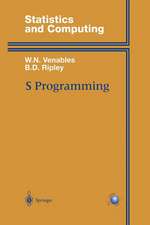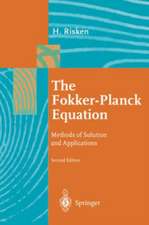An Introduction to Queueing Theory: and Matrix-Analytic Methods
Autor L. Breuer, Dieter Baumen Limba Engleză Paperback – 19 oct 2010
| Toate formatele și edițiile | Preț | Express |
|---|---|---|
| Paperback (1) | 387.75 lei 6-8 săpt. | |
| SPRINGER NETHERLANDS – 19 oct 2010 | 387.75 lei 6-8 săpt. | |
| Hardback (1) | 394.87 lei 6-8 săpt. | |
| SPRINGER NETHERLANDS – 7 noi 2005 | 394.87 lei 6-8 săpt. |
Preț: 387.75 lei
Nou
Puncte Express: 582
Preț estimativ în valută:
74.20€ • 77.73$ • 61.49£
74.20€ • 77.73$ • 61.49£
Carte tipărită la comandă
Livrare economică 08-22 aprilie
Preluare comenzi: 021 569.72.76
Specificații
ISBN-13: 9789048169139
ISBN-10: 9048169135
Pagini: 288
Ilustrații: XIV, 272 p.
Dimensiuni: 160 x 240 x 15 mm
Greutate: 0.41 kg
Ediția:Softcover reprint of hardcover 1st ed. 2005
Editura: SPRINGER NETHERLANDS
Colecția Springer
Locul publicării:Dordrecht, Netherlands
ISBN-10: 9048169135
Pagini: 288
Ilustrații: XIV, 272 p.
Dimensiuni: 160 x 240 x 15 mm
Greutate: 0.41 kg
Ediția:Softcover reprint of hardcover 1st ed. 2005
Editura: SPRINGER NETHERLANDS
Colecția Springer
Locul publicării:Dordrecht, Netherlands
Public țintă
ResearchCuprins
Queues: The Art of Modelling.- Markov Chains and Queues in Discrete Time.- Homogeneous Markov Processes on Discrete State Spaces.- Markovian Queues in Continuous Time.- Markovian Queueing Networks.- Renewal Theory.- Markov Renewal Theory.- Semi-Markovian Queues.- Phase-Type Distributions.- Markovian Arrival Processes.- The GI/PH/1 Queue.- The BMAP/G/1 Queue.- Discrete Time Approaches.- Spatial Markovian Arrival Processes.
Recenzii
From the reviews:
"This book provides a mathematical introduction to the theory of queuing theory and matrix-analytic methods … . The style of the text … is concise and rigorous. The proofs are presented for study. Each chapter concludes with a set of exercises inviting readers to prove supplementary results and review particular aspects of the theory. … I have found this to be a useful reference text and would recommend it to those wishing to delve into the mathematical theory of basic queuing theory." (Michael NG, SIAM Review, Vol. 48 (3), 2006)
"The book under review attempts to give an introduction to the theory of queues without losing contact with its applicability. … For instructors who prefer the topics covered, this book is a nice candidate as they do not need to choose the topics but only need to elaborate on them. Nevertheless, it would be a good reference book for an introductory course in queuing theory, stochastic modelling, or applied probability, and a valuable one to add to a professional’s bookshelf." (N. Selvaraju, Mathematical Reviews, Issue 2007 c)
"This book provides a mathematical introduction to the theory of queuing theory and matrix-analytic methods … . The style of the text … is concise and rigorous. The proofs are presented for study. Each chapter concludes with a set of exercises inviting readers to prove supplementary results and review particular aspects of the theory. … I have found this to be a useful reference text and would recommend it to those wishing to delve into the mathematical theory of basic queuing theory." (Michael NG, SIAM Review, Vol. 48 (3), 2006)
"The book under review attempts to give an introduction to the theory of queues without losing contact with its applicability. … For instructors who prefer the topics covered, this book is a nice candidate as they do not need to choose the topics but only need to elaborate on them. Nevertheless, it would be a good reference book for an introductory course in queuing theory, stochastic modelling, or applied probability, and a valuable one to add to a professional’s bookshelf." (N. Selvaraju, Mathematical Reviews, Issue 2007 c)
Caracteristici
Provides a systematic introduction to queueing theory within the framework of Markov renewal theory Covers phase-type distributions, Markovian arrival processes, the GI/PH/1 and BMAP/G/1 queues as well as QBDs and discrete time approaches This is the first textbook that contains an extensive presentation of matrix-analytic methods as a natural extension of classical methods Concise style makes it suitable for the blueprint of a lecture script















